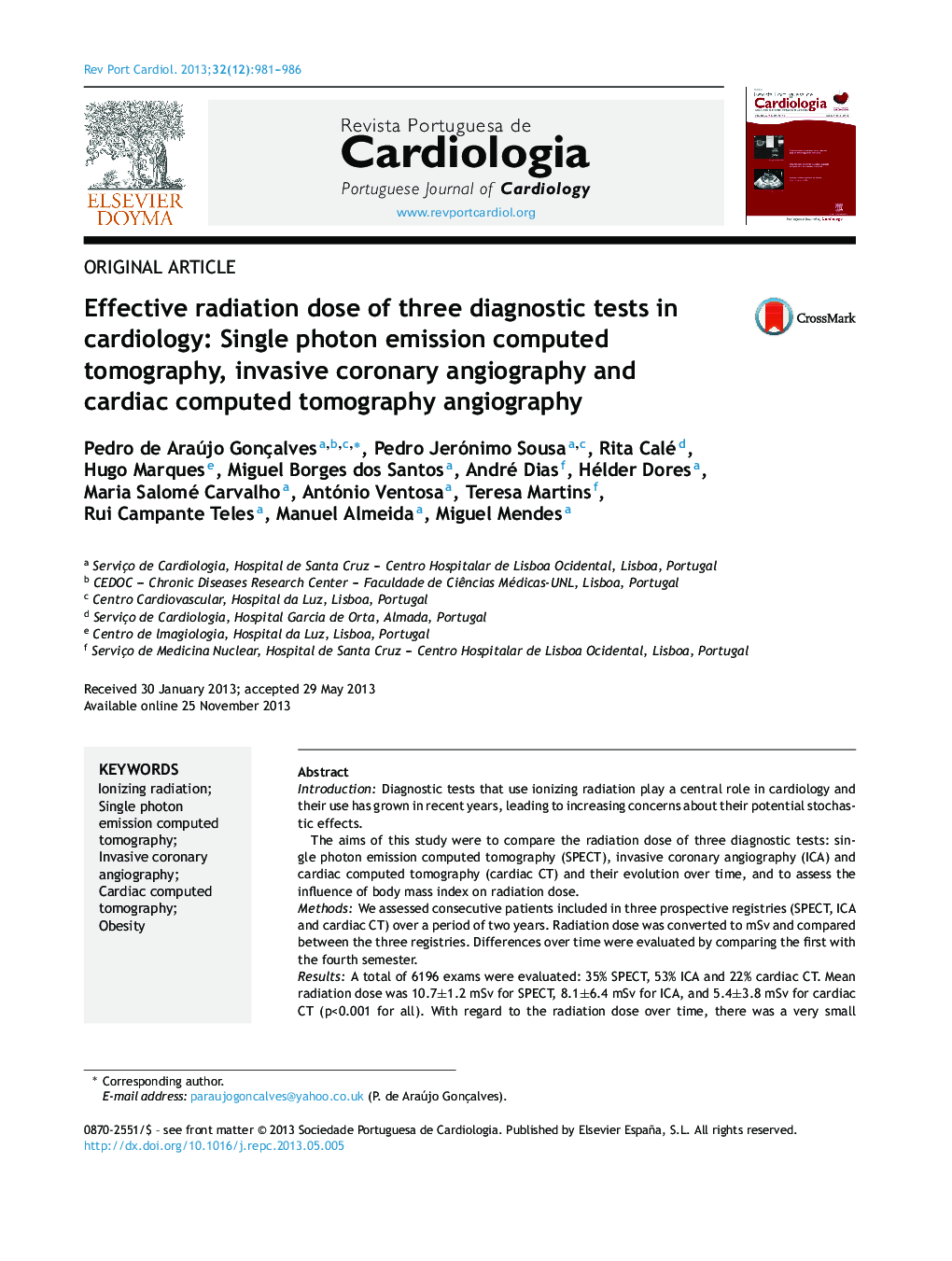| Article ID | Journal | Published Year | Pages | File Type |
|---|---|---|---|---|
| 1126180 | Revista Portuguesa de Cardiologia | 2013 | 6 Pages |
IntroductionDiagnostic tests that use ionizing radiation play a central role in cardiology and their use has grown in recent years, leading to increasing concerns about their potential stochastic effects.The aims of this study were to compare the radiation dose of three diagnostic tests: single photon emission computed tomography (SPECT), invasive coronary angiography (ICA) and cardiac computed tomography (cardiac CT) and their evolution over time, and to assess the influence of body mass index on radiation dose.MethodsWe assessed consecutive patients included in three prospective registries (SPECT, ICA and cardiac CT) over a period of two years. Radiation dose was converted to mSv and compared between the three registries. Differences over time were evaluated by comparing the first with the fourth semester.ResultsA total of 6196 exams were evaluated: 35% SPECT, 53% ICA and 22% cardiac CT. Mean radiation dose was 10.7±1.2 mSv for SPECT, 8.1±6.4 mSv for ICA, and 5.4±3.8 mSv for cardiac CT (p<0.001 for all). With regard to the radiation dose over time, there was a very small reduction in SPECT (10.7 to 10.5 mSv, p=0.004), a significant increase (25%) in ICA (7.0 to 8.8 mSv; p<0.001), and a significant reduction (29%) in cardiac CT (6.5 to 4.6 mSv, p<0.001). Obesity was associated with a significantly higher radiation dose in all three exams.ConclusionsCardiac CT had a lower mean effective radiation dose than invasive coronary angiography, which in turn had a lower mean effective dose than SPECT.There was a significant increase in radiation doses in the ICA registry and a significant decrease in the cardiac CT registry over time.
ResumoIntroduçãoOs exames diagnósticos que usam radiação ionizante têm um papel central na cardiologia e a par do seu uso crescente, tem aumentado a preocupação pelos seus potenciais efeitos estocásticos.Os objetivos deste estudo foram: 1) Comparar a dose de radiação de três exames: Cintigrafia de perfusão miocárdica (SPECT), coronariografia invasiva (CAT) e tomografia computorizada cardíaca (AngioTC) e a sua evolução temporal. 2) Avaliar o impacto do índice de massa corporal na dose de radiação.MétodosDoentes consecutivos incluídos em três registos prospetivos (SPECT, CAT e AngioTC) durante dois anos. A dose de radiação foi convertida a mSv e comparada entre os três registos. A evolução temporal foi avaliada por comparação do 1.° e 4.° semestres.ResultadosForam avaliados 6196 exames: 35% SPECT, 53% CAT e 22% AngioTC. A dose de radiação foi: 10,7 ± 1,2 mSv para o SPECT; 8,1 ± 6,4 mSv para o CAT; 5,4 ± 3,8 mSv para a AngioTC (p < 0,001 todas comparações).Evolução temporal da dose de radiação: redução muito ligeira no SPECT (10,7 para 10,5 mSv; p = 0,004); aumento significativo (25%) no CAT (7,0 para 8,8 mSv; p < 0,001); redução significativa (29%) na AngioTC (6,5 para 4,6 mSv; p < 0,001). A obesidade associou-se a níveis de radiação significativamente mais elevados nos três exames.ConclusãoO exame associado a uma menor dose de radiação foi a AngioTC, seguida do CAT que, por sua vez, foi menor que a do SPECT. Houve um aumento significativo da dose de radiação no registo CAT e uma redução significativa no registo da AngioTC ao longo do tempo.
